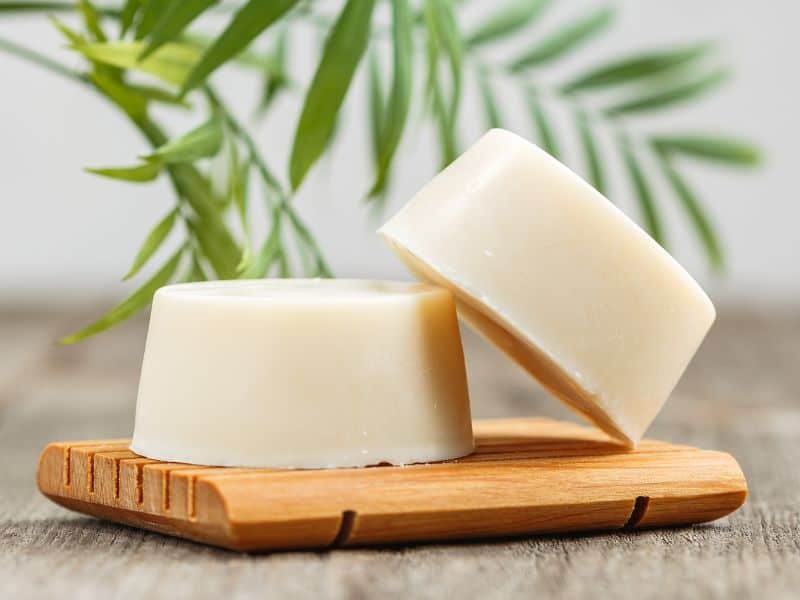Melt and pour soap is a popular choice for many soap makers. It’s easy, fun, and quick to create your own unique soaps. However, some may notice that their melt and pour soap tends to “sweat.” We are going to explore why melt and pour soap sweats, the factors that contribute to this issue, and how to prevent and troubleshoot it.
Melt and pour soap sweats because its glycerin content attracts moisture from the air. Humidity, higher glycerin levels, and improper storage all contribute to soap sweating, causing beads of moisture to form on the soap’s surface.
Glycerin is a byproduct of the saponification process, which occurs when fats and oils react with sodium hydroxide (lye) to produce soap. The higher the glycerin content in melt and pour soap, the more it will sweat. This is because glycerin has hygroscopic properties – meaning it absorbs moisture from the air. Keep reading, we will take a closer look at this issue.
Understanding Soap Sweat
Soap sweat refers to the small beads of moisture that appear on the surface of melt and pour soap. This phenomenon is a result of the glycerin content within the soap attracting water molecules from the surrounding air, giving the soap a sweaty appearance.
Glycerin is a humectant, which means it has the ability to draw and retain moisture. This property makes glycerin a popular ingredient in skincare products, as it provides moisturizing benefits to the skin.
However, the same property that makes glycerin beneficial for skincare can also cause melt and pour soap to sweat, particularly when exposed to humid conditions. The higher the glycerin content in the soap, the more likely it is to sweat.
In addition to humidity, other factors like the soap’s glycerin content and storage conditions can impact the extent of soap sweating. Understanding these factors can help you take the necessary precautions to minimize or prevent soap sweat in your homemade creations.
Factors Contributing to Soap Sweat
Humidity
In areas with high humidity levels, soap tends to sweat more easily. The moisture present in the air is drawn to the glycerin content in the soap. This attraction results in beads of moisture forming on the soap’s surface, giving it a sweaty appearance.
Glycerin content
Different melt and pour soap bases contain varying levels of glycerin. Glycerin is a humectant, which means it attracts and retains moisture. When a soap base has a higher glycerin content, it is more likely to sweat, particularly in humid conditions.
Storage conditions
Storing your soap improperly can also lead to soap sweat. When soap is exposed to moisture, high humidity, or fluctuating temperatures, it becomes more susceptible to sweating. It’s essential to store your soap in a stable environment to prevent these issues.
Soap cooling process
Allowing your soap to cool too quickly after pouring it into a mold can contribute to sweating. Rapid cooling can cause condensation to form on the surface of the soap, leading to sweat-like droplets. To minimize this issue, ensure the soap cools gradually in a controlled environment.
Preventing Soap Sweat
The good news is that there are a few things you can do to prevent melt and pour soap from sweating.
Prevent melt and pour soap from sweating, choose a low-glycerin soap base, store it in a cool, dry place, and let it cool gradually after pouring. Using additives like sodium lactate or clay can also help reduce sweating.
Steps you can take to help prevent the problem.
- Choose a low-sweat soap base: To reduce soap sweat, select a soap base with a lower glycerin content. These bases are specifically formulated to minimize sweating.
- Proper storage techniques: Store your melt and pour soap in a cool, dry place. Keep it away from humidity and moisture. Airtight containers or plastic wrap can help protect the soap from the elements.
- Use additives: Some additives, like sodium lactate or clay, can help reduce sweating in melt and pour soap. Experiment with these ingredients to find the right balance for your soap.
Troubleshooting Sweaty Soap
Fixing appearance issues
If your soap has visible sweat, gently pat it with a clean cloth or paper towel to absorb excess moisture. This can help improve the soap’s appearance without causing damage. Ensure the cloth or paper towel is lint-free to avoid leaving particles on the soap.
Saving soap with excess sweat
For soap with significant sweating, remelting and reformulating may be necessary. Melt the soap and mix it with a low-sweat soap base or incorporate additives, like sodium lactate or clay, to help reduce sweating. Pour the reformulated soap into a mold and allow it to cool gradually.
Tips for preventing future sweat problems
Maintain a log of the conditions when you create and store your soap, including temperature, humidity, and any additives used. This record can help you identify patterns, contributing factors, and areas for improvement. By adjusting your soap-making process and storage methods, you can better prevent soap sweat issues in the future.
Test different recipes
Experiment with various soap base and additive combinations to find the one that works best for your specific environment and preferences. Testing small batches can save time and resources while optimizing your soap-making process to prevent sweating.
Melt and Pour Soaps That Don’t Sweat
There are melt and pour soap bases available that are specifically formulated to minimize or prevent sweating. These low-sweat or reduced-sweat soap bases are ideal for soap makers who want to create beautiful, functional soaps without worrying about excessive sweating.
Here is a list of melt and pour soap bases that are known for their low-sweat properties:
- Our Earth’s Secrets Low Sweat Clear Melt and Pour Soap Base: Proudly made in the USA, this base features natural ingredients for a gentle and nourishing soap experience. This soap base boasts a unique low-sweat formula, allowing for a cold process appearance in a melt and pour base. It’s perfect for wrapping in paper due to its reduced ‘sweating’ properties. Click here to check the latest price for this soap base on Amazon.
- Crafters Choice Df Low Sweat Coconut Milk Soap Base: This soap Base offers a detergent-free, opaque, and white base perfect for crafting gentle and nourishing soap bars. It contains coconut milk, known for its high antioxidant content and excellent natural moisturizing properties for the skin. Since there’s no need to wrap the soap bars to prevent sweating, this base is similar to cold process soap. Click here to see the latest price for this soap base on Amazon.
- Crafter’s Choice Detergent Free Clear Low Sweat Melt & Pour Soap Base: A top choice for crafting gentle, high-quality soap bars. This clear glycerin soap base is both detergent-free and low-sweat, offering a low odor, easy-to-unmold product that holds fragrance well. The finished soap performs similarly to cold process soap. Proudly made in the United States, this soap base features non-GMO and sustainable ingredients like Coconut Oil and Palm Oil. Click here to see the latest price for this soap base on Amazon.
- Areej Hypo-Allergenic Biodegradable White Low Sweat Soap Base: Made with 100% pure natural glycerin – 2 pounds. Our soap bases feature 100% pure, natural Kosher glycerin, ensuring top-quality products. The palm oil used in our soap bases comes from RSPO-compliant companies, promoting sustainable practices. Our soaps are biodegradable and not tested on animals, reflecting our commitment to environmental responsibility. All of our oils come from sustainable growers, and we only use non-GMO raw materials in our soap bases. Click here to see the latest price for this soap base on Amazon.
- Primal Elements Shea Butter Moisturizing Melt and Pour Glycerin Soap Base: This vegan, cruelty-free soap base is easy to cut, allowing you to create unique soaps at home. This solid soap base is perfect for mixing and creating a variety of new soaps. Enhance your soap-making supplies by stocking up on this versatile base, perfect for crafting an array of homemade soaps. Click here to see the latest price for this soap base on Amazon.
When using low-sweat melt and pour soap bases, it’s essential to store your finished soap products properly to further reduce the risk of sweating.
Store your soaps in a cool, dry place, away from humidity and moisture. Using airtight containers or plastic wrap can help protect the soaps from external factors that may contribute to sweating.
In addition to using low-sweat soap bases, you can also experiment with additives like sodium lactate or clay to help reduce sweating in your melt and pour soaps.
By choosing the right soap base and following proper storage techniques, you can create beautiful, handmade soap bars that remain free of sweat and maintain their visual appeal and functionality.
Frequently Asked Questions
Prevent soap sweat by choosing a low-glycerin soap base, storing soap in a cool, dry place, cooling the soap gradually after pouring, and using additives like sodium lactate or clay.
Gently pat the soap with a clean, lint-free cloth or paper towel to absorb excess moisture and improve its appearance.
Keep track of the conditions when you create and store your soap, test different soap base and additive combinations, and adjust your process based on your findings.
Additives like sodium lactate and clay can help reduce soap sweat by improving the soap’s moisture balance and stabilizing its glycerin content.
Conclusion
In conclusion, understanding the factors contributing to melt and pour soap sweat, such as glycerin content, humidity, and storage conditions, is crucial for addressing this common issue. By taking preventive measures and applying troubleshooting techniques, you can ensure your homemade soap remains both visually appealing and functional.
Remember to experiment with different soap bases, additives, and storage methods to find the best approach for your unique situation. With this knowledge, you can continue your soap-making journey confidently. Happy soap making!






